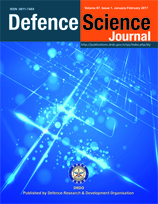Transformation Mechanism of Dual-mode Penetrators Achieved by Changing of Single-point Detonation
DOI:
https://doi.org/10.14429/dsj.1.9016Keywords:
single-point initiation, explosively formed projectile, jetting projectile charge, explosive pressure, numerical simulationAbstract
A shaped charge was produced with a wave shaper that can transform dual-mode penetrators by changing the single-point detonation location. Specifically, the theory of denotation wave formation was applied to analyze changes in the liner surface pressure in different initiation situations. An analytical model was established of the projectile explosively formed by denotation at the top of the liner and jetting projectile charge formed by denotation at the center of charge. LS-DYNA finite element simulation software was used to study the effects of the liner configuration parameters on the formation of dual-mode penetrators, and orthogonal optimizing design and simulation calculation was conducted to obtain suitable structural parameters of a uniform-thickness eccentric hemisphere liner. X-ray imaging and penetration experiments were then conducted. The penetration depth of the explosively formed projectile in a steel target was 0.64Dk(the charge diameter),while that of the jetting projectile charge was 2.42Dk when the burst height was approximately 13Dk.
Downloads
Additional Files
Published
How to Cite
Issue
Section
License
 Where otherwise noted, the Articles on this site are licensed under Creative Commons License: CC Attribution-Noncommercial-No Derivative Works 2.5 India
Where otherwise noted, the Articles on this site are licensed under Creative Commons License: CC Attribution-Noncommercial-No Derivative Works 2.5 India


